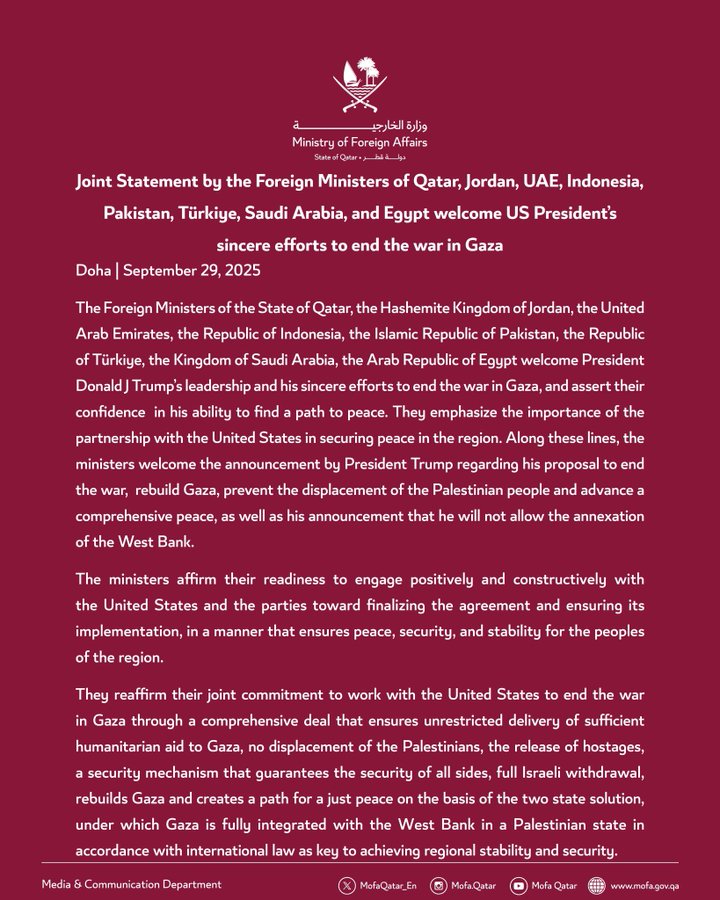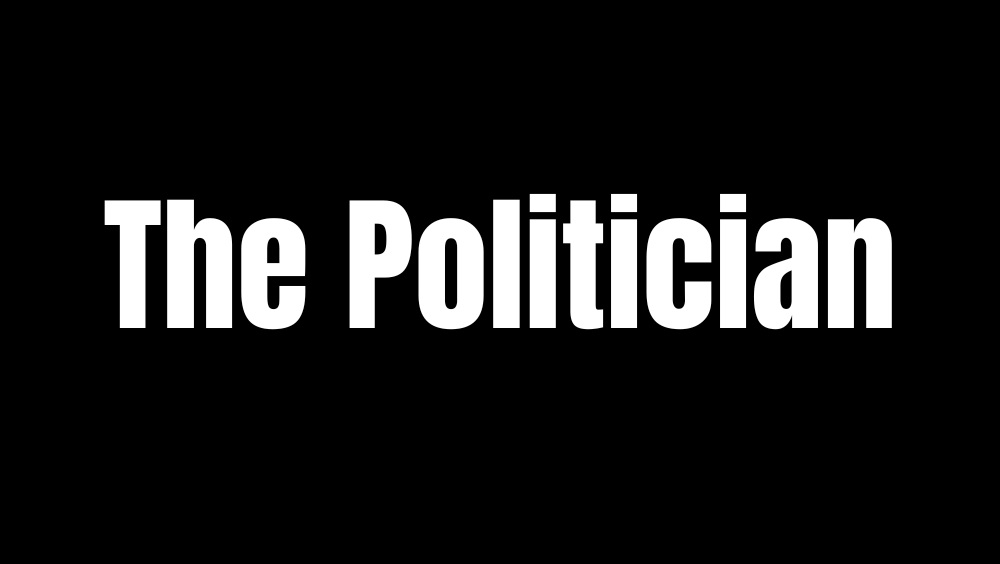Trump’s new Gaza plan: Will it finally move Hamas to lay down arms, because earlier ‘deadlines’ have not worked, and peace is still elusive
The Israel-Hamas War, which started with the massacre of Israeli civilians by the Palestinian Islamic terror group Hamas on 7th October 2023, might finally end with a peace plan for Gaza, proposed by US President Donald Trump. Though welcomed by many Islamic countries, and supported by neutral nations seeking an end to the conflict, Trump’s 20-point plan would work only if Hamas agrees to lay down arms before the given deadline. The problem with these ‘deadlines’ is that these are already ‘dead’ to a tone-deaf Hamas hell bent on fighting Israel to its end. On 29th September, President Trump unveiled a comprehensive peace plan to end the war in Gaza. During his visit to the White House, Prime Minister of Israel Benjamin Netanyahu publicly backed Trump’s proposal. Trump, however, admitted that Hamas has not agreed to the proposal so far. "Today is a historic day for peace — and Prime Minister @netanyahu and I have just concluded an important meeting…we discussed how to end the war in Gaza, but it's just a part of the bigger picture, which is peace in the Middle East." – PRESIDENT DONALD J. TRUMP pic.twitter.com/5f9PF9EC3c— The White House (@WhiteHouse) September 29, 2025 The main components of the proposal include the release of all the living and dead hostages in Gaza, imperative for Hamas to lay down arms, withdrawal of Israeli forces from the territory, the delivery of humanitarian aid, in addition the installation of a civilian governing authority for Palestinians. Not to be pessimistic, but the points of the proposal are quite telling that it may not actually work. The very first point of the proposal that Gaza will be “a deradicalised terror-free zone that does not pose a threat to its neighbours” is a near-impossible feat to achieve. The Palestinian people, including the Gazans, have, over the years, be it in elections or surveys, have expressed unwavering support for Hamas. To think that just because not all Gazans are armed, they are different from Hamas, is harbouring a delusion that will prove detrimental eventually. Besides turning Gaza into a ‘deradicalised terror-free zone’, the peace plan also proposes to redevelop Gaza “for the benefit of the people of Gaza, who have suffered more than enough.” The third point says that if both parties, Israel and Hamas, agree to the proposal, “the war will immediately end”. President Donald J. Trump’s Comprehensive Plan to End the Gaza Conflict:1. Gaza will be a deradicalized terror-free zone that does not pose a threat to its neighbors.2. Gaza will be redeveloped for the benefit of the people of Gaza, who have suffered more than enough.3. If… pic.twitter.com/veqhr9MW28— Rapid Response 47 (@RapidResponse47) September 29, 2025 “If both sides agree to this proposal, the war will immediately end. Israeli forces will withdraw to the agreed upon line to prepare for a hostage release. During this time, all military operations, including aerial and artillery bombardment, will be suspended, and battle lines will remain frozen until conditions are met for the complete staged withdrawal,” the proposal reads. The plan also includes a point that, within 72 hours of Israel publicly accepting this agreement, all hostages, alive and deceased, will be returned. Israel will release prisoners for hostages, but how will that work? “Once all hostages are released, Israel will release 250 life sentence prisoners plus 1700 Gazans who were detained after October 7th 2023, including all women and children detained in that context. For every Israeli hostage whose remains are released, Israel will release the remains of 15 deceased Gazans,” the proposal reads. Since the Israeli Prime Minister has agreed to and welcomed the Gaza Peace Plan, Israel would most likely release the Hamas Jihadis the Israeli forces took as prisoners and even release the Gaza civilians it detained. However, what is the guarantee that Hamas would, firstly, agree to this proposal in true spirit, and would not renege on its commitment once Gazans and Hamas terrorists are released by Israel? It must not be forgotten that in the 2011 Gilad Shalit exchange, Israel had freed Palestinian prisoners, including Yahya Sinwar, who went on to become a top Hamas leader and orchestrated the October 7 assault. The next point in the Gaza peace plan says that once all hostages are returned, “Hamas members who commit to peaceful co-existence and to decommission their weapons will be given amnesty. Members of Hamas who wish to leave Gaza will be provided safe passage to receiving countries.” This would basically become an export of Islamic Hamas terrorism to other receiving countries. The Islamic countries like Egypt, Jordan, Syria and Saudi Arabia, among others, have demonstrated nonchalance in inducting more Palestinian refugees. In such a case, it remains a question if Hamas terrorists who ‘commit to peaceful co-existence’ will be accommodated in non-Islamic or secular countries.



The Israel-Hamas War, which started with the massacre of Israeli civilians by the Palestinian Islamic terror group Hamas on 7th October 2023, might finally end with a peace plan for Gaza, proposed by US President Donald Trump. Though welcomed by many Islamic countries, and supported by neutral nations seeking an end to the conflict, Trump’s 20-point plan would work only if Hamas agrees to lay down arms before the given deadline. The problem with these ‘deadlines’ is that these are already ‘dead’ to a tone-deaf Hamas hell bent on fighting Israel to its end.
On 29th September, President Trump unveiled a comprehensive peace plan to end the war in Gaza. During his visit to the White House, Prime Minister of Israel Benjamin Netanyahu publicly backed Trump’s proposal. Trump, however, admitted that Hamas has not agreed to the proposal so far.
"Today is a historic day for peace — and Prime Minister @netanyahu and I have just concluded an important meeting…we discussed how to end the war in Gaza, but it's just a part of the bigger picture, which is peace in the Middle East." – PRESIDENT DONALD J. TRUMP pic.twitter.com/5f9PF9EC3c
— The White House (@WhiteHouse) September 29, 2025
The main components of the proposal include the release of all the living and dead hostages in Gaza, imperative for Hamas to lay down arms, withdrawal of Israeli forces from the territory, the delivery of humanitarian aid, in addition the installation of a civilian governing authority for Palestinians. Not to be pessimistic, but the points of the proposal are quite telling that it may not actually work.
The very first point of the proposal that Gaza will be “a deradicalised terror-free zone that does not pose a threat to its neighbours” is a near-impossible feat to achieve. The Palestinian people, including the Gazans, have, over the years, be it in elections or surveys, have expressed unwavering support for Hamas. To think that just because not all Gazans are armed, they are different from Hamas, is harbouring a delusion that will prove detrimental eventually.
Besides turning Gaza into a ‘deradicalised terror-free zone’, the peace plan also proposes to redevelop Gaza “for the benefit of the people of Gaza, who have suffered more than enough.”
The third point says that if both parties, Israel and Hamas, agree to the proposal, “the war will immediately end”.
President Donald J. Trump’s Comprehensive Plan to End the Gaza Conflict:
— Rapid Response 47 (@RapidResponse47) September 29, 2025
1. Gaza will be a deradicalized terror-free zone that does not pose a threat to its neighbors.
2. Gaza will be redeveloped for the benefit of the people of Gaza, who have suffered more than enough.
3. If… pic.twitter.com/veqhr9MW28
“If both sides agree to this proposal, the war will immediately end. Israeli forces will withdraw to the agreed upon line to prepare for a hostage release. During this time, all military operations, including aerial and artillery bombardment, will be suspended, and battle lines will remain frozen until conditions are met for the complete staged withdrawal,” the proposal reads.
The plan also includes a point that, within 72 hours of Israel publicly accepting this agreement, all hostages, alive and deceased, will be returned.
Israel will release prisoners for hostages, but how will that work?
“Once all hostages are released, Israel will release 250 life sentence prisoners plus 1700 Gazans who were detained after October 7th 2023, including all women and children detained in that context. For every Israeli hostage whose remains are released, Israel will release the remains of 15 deceased Gazans,” the proposal reads.
Since the Israeli Prime Minister has agreed to and welcomed the Gaza Peace Plan, Israel would most likely release the Hamas Jihadis the Israeli forces took as prisoners and even release the Gaza civilians it detained. However, what is the guarantee that Hamas would, firstly, agree to this proposal in true spirit, and would not renege on its commitment once Gazans and Hamas terrorists are released by Israel?
It must not be forgotten that in the 2011 Gilad Shalit exchange, Israel had freed Palestinian prisoners, including Yahya Sinwar, who went on to become a top Hamas leader and orchestrated the October 7 assault.
The next point in the Gaza peace plan says that once all hostages are returned, “Hamas members who commit to peaceful co-existence and to decommission their weapons will be given amnesty. Members of Hamas who wish to leave Gaza will be provided safe passage to receiving countries.”
This would basically become an export of Islamic Hamas terrorism to other receiving countries. The Islamic countries like Egypt, Jordan, Syria and Saudi Arabia, among others, have demonstrated nonchalance in inducting more Palestinian refugees. In such a case, it remains a question if Hamas terrorists who ‘commit to peaceful co-existence’ will be accommodated in non-Islamic or secular countries. If yes, then who will give the guarantee that these ‘former’ Hamas terrorists would not soon return to their old ways and perhaps carry on their Jihadist activities in host nations? Basically, the amnesty for ‘peace-committing’ Hamas Jihadis could embed sleeper cells and safe passage for others might allow them to regroup and even establish strongholds in neighbouring countries.
The proposal provides for supplying humanitarian aid to Gaza, if and when both conflicting parties agree to the plan.
‘Board of Peace’, headed by Donald Trump
Importantly, the Gaza Peace Plan proposed by President Trump states that “Gaza will be governed under the temporary transitional governance of a technocratic, apolitical Palestinian committee, responsible for delivering the day-to-day running of public services and municipalities for the people in Gaza. This committee will be made up of qualified Palestinians and international experts, with oversight and supervision by a new international transitional body, the “Board of Peace,” which will be headed and chaired by President Donald J. Trump, with other members and heads of State to be announced, including Former Prime Minister Tony Blair.
“This body will set the framework and handle the funding for the redevelopment of Gaza until such time as the Palestinian Authority has completed its reform program, as outlined in various proposals, including President Trump’s peace plan in 2020 and the Saudi-French proposal, and can securely and effectively take back control of Gaza. This body will call on best international standards to create modern and efficient governance that serves the people of Gaza and is conducive to attracting investment,” the point number 9 of the proposal adds.
The plan further proposes a “Trump economic development plan to rebuild and energise Gaza”. It adds that “many thoughtful investment proposals and exciting development ideas have been crafted by well-meaning international groups…to attract and facilitate these investments that will create jobs, opportunity, and hope for future Gaza.”
The plan also promises that a special economic zone will be established with preferred tariff and access rates to be negotiated with participating countries.
Apparently, had there been any rare earth deposits in Gaza, America’s ‘plane of democracy’ would have landed there years ago.
Can Hamas be trusted, can it be truly rooted out?
Under point number 13, the plan says that Hamas and other armed factions will agree not to have any role in the governance of Gaza, directly, indirectly, or in any form.
“All military, terror, and offensive infrastructure, including tunnels and weapon production facilities, will be destroyed and not rebuilt. There will be a process of demilitarization of Gaza under the supervision of independent monitors, which will include placing weapons permanently beyond use through an agreed process of decommissioning, and supported by an internationally funded buy-back and reintegration program, all verified by the independent monitors,” the point reads.
This is basically telling Hamas, a well-funded, dominant and popular (among Palestinians and the Islamists globally), that it must cease to exist. However, it is highly unlikely that Hamas will agree to this. Even if it does secure an immediate reprieve from Israel’s hammering, the countries funding this Islamic terror outfit will not truly allow Hamas’s cascading into oblivion.
The peace plan also proposes that the United States “will work with Arab and international partners to develop a temporary International Stabilisation Force (ISF) to immediately deploy in Gaza.” Again, this will truly work only if Hamas does not backtrack from its commitment and refrains from regrouping to ‘liberate’ Gaza. If Hamas returns to its old violent ways somehow, the ISF and Hamas will engage in conflict; thus, Gaza will become what it was before the peace plan’s implementation, a conflict zone.
The ISF’s Arab-led composition is innovative, perhaps driven by the idea that Hamas would not engage in conflict with Arab-led forces due to shared Muslim religious identity. However, this shared identity, though Shia-Sunni differences exist, could not prevent the Saudi-Houthi conflict. It is also not impossible that Hamas would seek Iran-backed Hezbollah support to ensure weapons, funds and logistics supply. In a nutshell, Shia and Sunni hate Israel more than they hate each other.
Israel will always have to remain cautious about its safety since the plan states that Israel will not occupy or annex Gaza and “once the ISF establishes control and stability, the Israel Defense Forces (IDF) will withdraw based on standards, milestones, and timeframes linked to demilitarization that will be agreed upon between the IDF, ISF, the guarantors, and the United States, with the objective of a secure Gaza that no longer poses a threat to Israel, Egypt, or its citizens.”
Point 17, a contingency plan in case Hamas disagrees?
Point number 17 of the Gaza peace plan says that “in the event Hamas delays or rejects this proposal, the above, including the scaled-up aid operation, will proceed in the terror-free areas handed over from the IDF to the ISF.” Does this mean that ISF will be formed regardless of Hamas’s agreement or disagreement with the proposal? The point’s phrasing hints at a contingency where, if Hamas does not agree, the peace plan’s humanitarian and stabilisation components, particularly, aid delivery and ISF, will move forward in zones cleared by the Israeli Defence Forces as “terror-free”. Apparently, the ISF’s formation is not contingent on Hamas’s approval.
The proposal’s points 19 and 20 say that when Gaza development advances and reform of the Palestinian Authority (PA) is carried out, “a credible pathway to Palestinian self-determination and statehood, which we recognise as the aspiration of the Palestinian people.”
It further states that the US will establish a dialogue between Israel and the Palestinians to agree on a political horizon for peaceful and prosperous co-existence.
While it is true that we only make peace with our enemies, not our friends, the Palestinian populace, including Hamas terrorists, is not going to have a sudden change of heart towards Israel and Jews.
The majority of Gazans and Palestinians are Sunni Muslims. While Trump wants Palestinians to agree on a ‘political horizon’ for a peaceful co-existence, Palestinians care only about the ‘religious horizon’. If this were not the case, the local populace would have pressured Hamas to release Israeli hostages and engage in dialogue with Israel. However, despite the violence, chaos, destruction and derailment of normal life, Gazans cheered when Hamas paraded dead bodies of four Israeli hostages, including a woman and her two infants, in February this year before handing them over to Israel.
Point 18 is wishful thinking: ‘From the river to the sea’ won’t be forgotten just like that
Now let’s discuss point number 18 of Trump’s Gaza Peace Plan, which says, “An interfaith dialogue process will be established based on the values of tolerance and peaceful co-existence to try and change mindsets and narratives of Palestinians and Israelis by emphasising the benefits that can be derived from peace.”
This point almost confirms why Hamas will not agree to this plan, and deem it as a victor’s document detailing terms and conditions of surrender. This proposed interfaith dialogue process, based on tolerance and peaceful co-existence values, will never truly succeed in changing ‘mindsets and narratives’, at least not of the Palestinian people. The Israel-Palestine/Hamas conflict is not simply a war for a piece of land or a conflict arising out of a prejudiced mindset and narratives. It is rooted in Islamic hatred for the Jews.
Hamas enjoys popular support of Palestinians, and the Hamas Covenant of 1988, also known as the Hamas Charter, outlines Hamas’s ideological standpoint regarding Israel, Palestine, and the larger conflict between Jews and Muslims. One of the key assertions in the charter is that all of Israel, from the Jordan River to the Mediterranean Sea, is considered Waqf land that belongs exclusively to Muslims.
This argument is based on the concept that once a land has been claimed by Islam, it will never return to non-Muslim control. Thus, Hamas considers all of Israel to be ‘illegitimately occupied’ by the Jews and is hell-bent on bringing it under Islamic autonomy.
The Palestinian Islamic terrorist group Hamas has clearly stated in its charter that the Palestinian movement aims to establish the supremacy of Allah over “every inch of Palestine”.
The Hamas Charter has declared Israel as an Islamic Waqf hallowed for the coming Muslim generations until the Yawm ad-Din or Judgment Day.
“The land of Palestine is an Islamic Waqf [Holy Possession] consecrated for future Moslem generations until Judgment Day. No one can renounce it or any part, or abandon it or any part of it,” Article 11 of the Hamas Charter reads.

The very reason why all the efforts by Israel to reach a peaceful solution to the Israel-Palestine dispute have gone in vain can be understood from Article 13 of the Hamas Charter ,which outrightly dismisses even any possibility of a peaceful resolution of the dispute with Israel as a “waste of time” since “Jews are infidels and only Jihad is the solution.” Hamas’ unwillingness to recognise Israel’s right to exist, as well as its desire for its annihilation, as written in the Hamas Charter, leaves no room for any peace talks.
“[Peace] initiatives, and so-called peaceful solutions and international conferences are in contradiction to the principles of the Islamic Resistance Movement… Those conferences are no more than a means to appoint the infidels as arbitrators in the lands of Islam… There is no solution for the Palestinian problem except by Jihad. Initiatives, proposals, and international conferences are but a waste of time, an exercise in futility,” Article 13 of the Hamas Charter states.
Hamas also called for the slaughtering of Jews and asserted that the “Judgment Day” would not come until the Muslims fight and kill the Jews. To back its call to violence, Hamas cites references to the Islamic text.
“The Day of Judgment will not come about until Moslems fight Jews and kill them. Then, the Jews will hide behind rocks and trees, and the rocks and trees will cry out: ‘O Moslem, there is a Jew hiding behind me, come and kill him,” Article 7 of the Hamas Charter reads.

While one would argue that it may be Hamas’s extremist ideology and not necessarily the opinion of the entire Muslim world, or at least of all Palestinian Muslims. However, the Islamic verse mentioned in Hamas Charter’s Article 7 is taken from the Islamic text Sahih Al Bukhari (a collection of Hadith and book of Sunnah) which reads: “The hour will not come until the Muslims fight the Jews and the Muslims kill them, until the Jew hides behind the stones and trees and the stones or trees say, ‘O Muslim, O servant of Allah, this is a Jew behind me, come and kill him.”

In short, hatred against Jews and Israel is not just an ideological problem confined to Hamas and other such extremist groups, but is mandated in the Islamic texts. Thus, only if, somehow, all of the Palestinian Muslims decide to abandon Islam or reject the Islamic texts or verses commanding them to wage Jihad against Jews, forget that prosperous, even peacefu,l co-existence is impossible.
Failed ceasefires, unmet deadlines have happened before
Besides, there is also a history of failed deadlines and ceasefires between Israel and Hamas. The first ceasefire agreement, starting from 24th November 2023, broke down on 1st December 2023, after Israel resumed full military operations since Hamas violated the ceasefire. Between December 2023 and January 2024, multiple proposals also did not yield lasting positive results. The second major ceasefire comprising 6-week phases also fell apart despite Hamas releasing 18 living hostages and Israel freeing over 730 prisoners. As Hamas continued to mobilise forces, Israel conducted airstrikes on 18th March 2024. Even the US tried to intervene; however, it could not secure a lasting ceasefire.
Despite there not being much hope for Hamas to agree to the Trump Gaza Peace Plan, the foreign ministers of Islamic countries, Qatar, Jordan, UAE, Indonesia, Pakistan, Turkey, Saudi Arabia, and Egypt have issued a joint statement welcoming the proposal. They also lauded Trump’s commitment to block any Israeli annexation of the West Bank. In their statement, the ministers affirmed their “readiness to engage positively and constructively” with the United States and other parties to finalise and implement the agreement.

Interestingly, most of these countries do not even recognise Israel’s right to exist. However, they see a silver lining in the proposed peace plan. These Islamic countries will not have to take in Gazan refugees on a massive scale. The biggest hypocrite, however, remains the Islamic Republic of Pakistan. Pakistan does not recognise Israel, its people and politicians hate Israel to the core and often give “Delete Israel” calls. However, with their backing to Trump’s peace plan, Pakistan, which is governed by Madarsa-bred Field Marshal Asim Munir, as its de facto ruler, has pivoted towards officially recognising Israel. It also won’t be a surprise if Pakistan ends up joining the Abraham Accords and establishes diplomatic ties with Israel.
Even the Palestinian Authority has also welcomed Trump’s “sincere and determined efforts to end the Gaza war”. In a statement, PA said that it “welcomes the sincere and determined efforts of President Donald J Trump to end the war on Gaza, and affirms its confidence in his ability to find a path toward peace.”
It is, however, pertinent to mention that the Palestinian Authority had, in 2023, condemned Hamas’s October 7 onslaught only to backtrack later. Not only this, a one-page document dated 18th October 2023 was issued by the Palestinian Authority’s Ministry of Endowments and Religious Affairs. The document issued to imams of mosques laid down directives for Friday (Jummah) sermons. This document contained the same Islamic verse Hamas cited in its charter, which calls for the murder of all Jews by Muslims.
Will a piece of paper stop Islamic terrorists?
However, while it is easy to propose a peace plan, it is delusional to expect hardened Islamic terrorists to suddenly start believing in peaceful coexistence and lay down arms. The question remains that even if Hamas somehow declares that it will support the peace plan, is a piece of paper stating they won’t arm again is going to be enough to keep them unarmed and unorganised? Trump-led Gaza Peace Plan is full of optimism, sure, but it comes across as divorced from ground realities beyond the scope of the deplorable state of the Gazan people and a dire need for the return of normalcy.
"Instead of Hamas isolating us, we isolated Hamas. Now the entire world, including the Arab and Muslim world, is pressuring Hamas to accept the terms… to release all our hostages… while the IDF remains in most of the Strip"
— B.M. (@ireallyhateyou) September 30, 2025
That was fast: Netanyahu reveals his own bluff. He… https://t.co/Gk3TfR9WFM pic.twitter.com/haJdEAdVZn
While Trump’s peace plan and its endorsement by Islamic countries may solidify his Nobel Peace Prize claim, it’s more a tactical pause than a ‘final’ solution and peace remains elusive. Perhaps for this reason, Trump said that if Hamas does not agree to the Gaza Peace Plan, he will back Israel to “finish the job”. It seems that the much-hyped peace plan might crash even before take off, as Prime Minister Netanyahu has said that the IDF “will remain in most of the territory” as part of the plan drawn up with Trump, and that Israel did “absolutely not” agree to a Palestinian state

























































































































